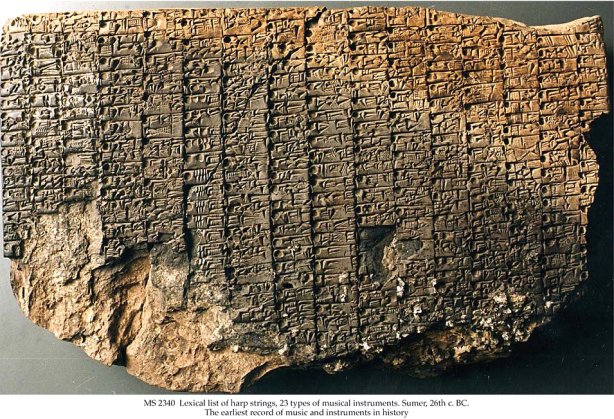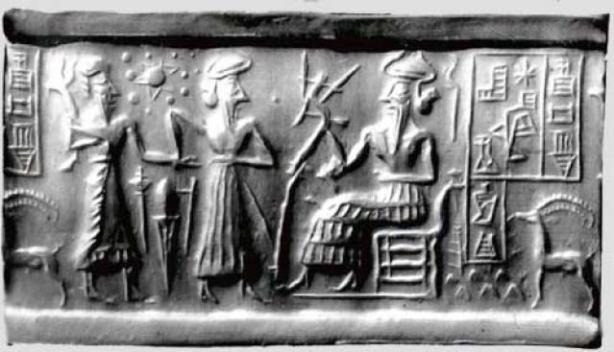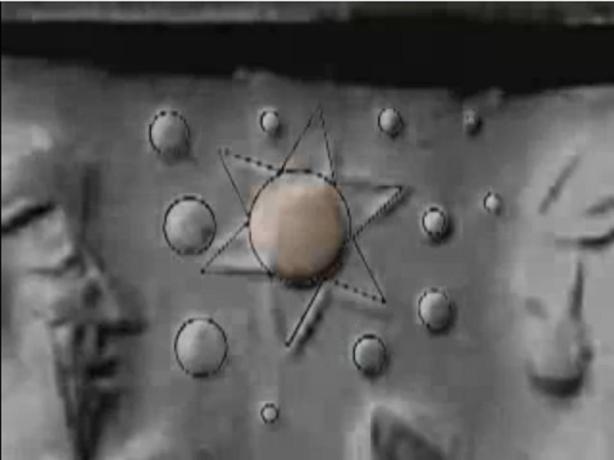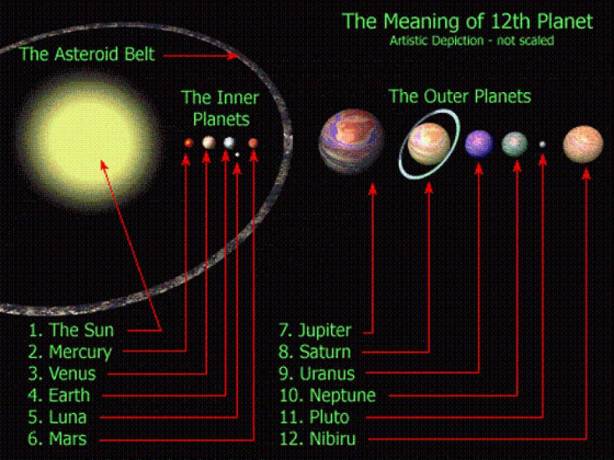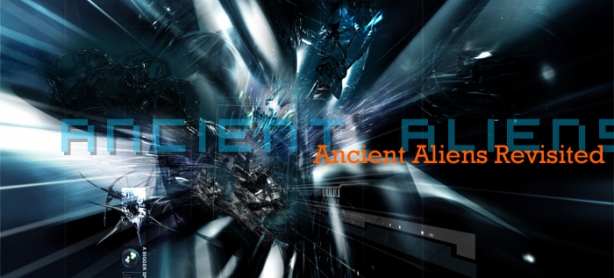
Our story does not even begin until the mid 1800’s because it was then that archeologists first discovered the remains of the ancient civilization of Sumer. The subsequent wealth of hitherto unknown records meticulously documented on, not hundreds or thousands, but tens of thousands of clay tablets uncovered by archeologists that were compiled by the scribes of this ancient culture has since astounded Archeologists, Theologians and scholars alike. The Ancient civilization of Sumer existed in the area of the Persian Gulf that was once known as Mesopotamia (now southern Iraq). The Sumerian writings are perhaps the oldest record of an actual civilization that we have any real knowledge of and, through clay tablets, cylinder seals and stele, the Sumerians have provided us with a graphic and richly detailed version of mans early histories including the story of creation, both of the earth and of man.
The texts also tell us of fierce and devastating wars fought over the possession and control of the Earths resources that ultimately led to the utter destruction of the Sumerian civilization. Many of these ancient texts are written in complex metaphor. In this respect the Sumerians were no exception and the texts can still be interpreted in this manner to reveal fantastic and epic stories of no apparent, or obscure mythological, meaning. However a new insight into the real method of translating them has now opened up an entire new meaning so that now, in complete contrast to the Christian or even the Babylonian creation myths which still remain full of constant symbolism, vagueness and metaphor, the earlier Sumerian version of the story can be viewed as an almost scientific account of a series of well documented events that happened in a very specific timeline.
It has now been universally agreed by both scholars and Theologians alike that the biblical story of creation does indeed have its basis in the Babylonian ‘Enuma Elish’ which itself is undoubtedly an abbreviated versions of the much earlier Sumerian texts. This can be easily confirmed as a great many parallels that can be seen in the Sumerian account when it’s compared to the Babylonian and Christian creation stories. It appears obvious that both of the latter accounts were heavily influenced by the much longer and more detailed Sumerian story. The Sumerian account of the creation of the earth and the rise of man, as controversial as it may be, is strangely enough, the only tale that adequately provides a scientific explanation that is plausible for not just the earth and mankind, but for many other puzzling aspects of our solar system too. I’d say that’s quite a reasonable achievement for 6000 year old cuniform and hieroglyphic texts carved into tablets.
A vividly detailed interpretation of these Sumerian texts was done by the brilliant, though controversial scholar and archeologist, Zechariah Sitchin who then published his findings in a Masterwork he aptly named ‘The Earth Chronicles’. The astounding work consists of a series of 6 books of detailed translations and interpretations to date. Sitchin is a respected archeologist who worked for several decades on Sumerian translations and archeological sites. His books are intelligently presented, meticulously researched, highly informative and extremely well documented works, containing details on almost every aspect of the texts and I highly recommend reading them. It dawned on Sitchin that since the Babylonian tale has its roots in the Sumerian account it, a better understanding of the texts may be achieved if one was to interpret the Babylonian cosmology of the tale as actually being Sumerian. Using this new approach, and in a labor of over 50 years Sitchin, has since painstaking pieced the story together from fragments of Sumerian, Babylonian, Akkadian, Assyrian, Hittite, Canaanite, Egyptian and Hebrew sources into a most remarkable and scientific account of our real beginnings.
The story that Sitchin found emerging from these tablets was so controversial, the implications so explosive for mankind that many people have found it extremely difficult to take the story at face value. Yet every single anomaly we are faced with about our Earth, our Solar System, and ourselves is mentioned and explained in these 6000 year Sumerian accounts. The enormous bulk of evidence he also presents to support his conclusions is literally, quite overwhelming.
Much of the earlier Sumerian Tale can still be gleaned from studying the Christian story of Genesis in particular the Hebrew version but of course much of the translation is open to interpretation and it is mainly in this respect that the tales differ, though the earlier Sumerian version is undoubtedly more complete. In his book ‘the 12th Planet’ Sitchin aptly points out translational errors. For example: The Christian story tells us that “In the beginning, God created the Heaven and the Earth”. But if we look at it in the Hebrew what is actually written is: “In the beginning God created the Rakia and the Earth”. Sitchin points out that the Hebrew word Rakia also has several possible translations depending on its context and one of those translations is ‘firmament.’ Therefore in the Christian tale, the word Rakia has been translated as ‘firmament’ and is interpreted as ‘heaven.’ As in the Sumerian story, in the Babylonian tale, via an awful lot of metaphor, we are informed as to the order of birth of all the planets but in respect to the earth, we are told that it was the god ‘Marduk’ who slew the ‘haughty dragon’ Tiamat and did the creating. Marduk was a supreme God of ancient Babylon so in many ways the statement is virtually identical to what is said in the Christian Bible if you want to take it that way. However in the Sumerian version of events we are basically told that it was the ‘Celestial Lord’ Nibiru who created the Rakia and the Earth.
Now Nibiru, is thought to be an specific Sumerian god so again it can mean the same thing as what we started with. But here’s the thing, to the ancient Sumerians, Nibiru is also known to have been used as a reference to a celestial body – a planet, and they are quite specific about this. As has been noted by Sitchin, another translation of the Hebrew word Rakia is “hammered bracelet” and that is also quite significant. It all lies in the personal interpretation of the Hebrew texts you see. So with a more open and honest approach to the translations, the Christian story of: ‘In the beginning God created the Heaven and the Earth’ Very easily translates to reveal the earlier Babylonian and Sumerian versions of: Marduk/Nibiru created the Hammered Bracelet and the Earth”. And the Sumerian texts are quite specific about how these events transpired.
The Hammered Bracelet referred to in the Sumerian texts is of course a very adequate and quite accurate description of the Asteroid belt in our solar system that lies in between the orbits of Mars and Jupiter. So in reality, we find that the ‘hammered bracelet’ translation is actually far more in context with our known solar system than that of ‘heaven.’ It is also quite significant that Bodes Law shows that there should in fact be another planet existing in our solar system at the location of the asteroid belt. There is every sign to suggest there once was but instead, all we find there now is an enormous collection of rocks, debris and cosmic rubble stretching out in a vast ring around the sun (like a ‘hammered bracelet’). Bodes Law also heavily suggests that there should be at least one more planet in our solar system. Such a planet was positively confirmed in late 2005.
From their texts, it would appear that the Sumerians were in possession of quite a significant amount of scientific and astronomical knowledge and knew of all these things. For example: Uranus was unknown until 1781 and Neptune until 1846. In modern astronomy we didn’t even know our solar system had as many as 9 planets orbiting the Sun until 1936 when Pluto was discovered. It had been previously thought that there were only 8 and yet the Sumerians already knew of the existence of all of these planets 6000 years ago including our newly discovered member which now makes 10 even as Bodes Law suggested, though the Sumerian texts say that there are actually 12 planets, not 10 or even 11 (as shown in the figure above).
As the diagram shows the reasons for this discrepancy are firstly, because they considered the Sun to be a rightfully included member of the Solar System and secondly, because they believe our moon actually has a considerable history of its own. Many scientists and scholars have surmised that our moon is too big to be called a real satellite and have debated whether the Earth and the Moon should really be classed as a double planetary system. The Sumerian believed it to be so and their name for the celestial body we know as the moon was ‘Luna’.
The other planet that also exists in our solar system, the one that we have only now discovered, they name as ‘Nibiru, the planet of the crossing.’ The Sumerians say that Nibiru is a large planet, possibly comparable in size to Saturn or Uranus and that it has an extremely vast elliptical orbit and that it takes 3600 of our years to complete just one orbit around our Sun. They also say that Nibiru is the dwelling place of the ‘Anunnaki,’ their Gods. Numerous mentions of the Anunnaki are made in various religious texts including the Christian Bible in which they are often referred to as the ‘Elohim’ and the ‘Nephilim’ or sometimes in more recent versions of the bible merely as ‘giants.’
In their texts the Sumerians repeatedly state that time flows differently on Nibiru than how it flows on earth. They stress the point that the flow of time on any given planet is directly related to the time it takes that planet to orbit its parent star, in this case, the Sun. This means for example, that since it takes 12 earth years for Jupiter to orbit the Sun, a man living on Jupiter for one orbit, would only physically age on year as apposed to someone on standing on earth who would age 12 years in the same period of Earth time. It therefore stands to reason that a person who lived on a planet that takes 3,600 earth years to orbit the Sun would also only age one year during that orbital timeframe. Such discrepancies in time are actually proven in part by Einstein’s Special theory of Relativity and it is well known how time flows slower for astronauts when they are away from earths rotational pull for example. Einstein even speculated that time was a type of ‘fabric’ that the planets ‘roll’ across similar to a ball rolling across a strip of linen.
The Sumerians inform us that one year on planet Nibiru was called a shar and was equivalent in time to 3,600 Earth years. They also say that the average Anunnaki lifespan was around about 120 shars which equates to 120 times 3600 or 432,000 earth years. According to the Sumerian King List a period of 120 shars passed from the time the Anunnaki first arrived on Earth until the time of the Great Flood. This is extremely significant as 432,000 is a number that also features very highly in numerous other mythologies as well.
Now before you start dismissing all this offhand, I again stress to you and ask you to remember that as far-fetched and bizarre as all that may sound to you, that this is not a fantasy tale contrived by myself or by Zechariah Sitchin, but is in fact gleaned from translations of 6000 year old Sumerian clay tablets. And as we progress you will see that the Sumerian account really is the most plausible explanation of creation that exists. It is also worth noting that the Sumerian record of events is the only account that provides totally a plausible series of events that adequately explains every single puzzle we are faced with about the rest of our solar system too. The fact they knew of all of the planets in our solar system, even their correct relative sizes, rotational movements and eccentricities, details that take advanced scientific knowledge to discover, plus of the existence of the asteroid belt also raises the question: If their story is untrue then how on earth were they able to acquire such accurate and detailed knowledge?
Let’s face it, how in the world were these ancient peoples ever even able to calculate precession of the equinoxes? Mere knowledge of its existence requires some very advanced scientific know-how. For now just consider the fact that it takes 72 years for the vernal point to move through just one degree of the elliptic – would you notice a 1 degree change in the location of the stars in 72 years? …No, I didn’t think so.The Sumerians called such a one degree shift in the heavens a “Celestial Portion.”
The Sumerian story of creation begins at a far earlier time than the Christian version though two stories do eventually overlap. The Sumerian version however, begins with the actual creation of the solar system. The second stage of creation then proceeds with an enormous cosmic collision. According to the tale a huge ‘rogue’ planet named as Nibiru that was not originally part of our planetary system became drawn into the gravitational pull of our outer planets and eventually the Sun and began an enormously vast, elliptical and permanent orbit. The texts say that Nibiru’s orbit is in fact, so eccentric and elliptical that during its perihelion it crosses the paths of all the other planets except the inner most four, making its closest pass precisely where we now find the asteroid belt. They also tell us that the orbit of this ‘rogue planet’ was contrary to the paths of the other planets of the system causing it to travel around the Sun in the opposite direction to them. It was during its entry to our solar system and on the second subsequent orbit, while making close orbital passes of the inner planets that two enormous celestial disasters occurred.
And as you read this account I am about to relate to you, as bizarre as it sounds, I ask you to consider deeply what you know of science and astronomy and also of mythology and biblical tales and again remember that the following tale is not from someone’s imagination but is in fact an accurate (though paraphrased) translation compiled from an account of our beginnings that was written by the Sumerians 6000 years ago and saved on tens of thousands of clay tablets that have been found in Mesopotamia in the last 150 years, the information their fragments and pieces contain collected, painstakingly reassembled and meticulously researched by Zechariah Sitchin, the world leading authority on Sumerian texts. Now with all of the above in mind, according to the 6000 year old Sumerian account, the actual creation of the Solar System, including the creation of Hammered Bracelet and the Earth, and ultimately of man, the calendar, civilization and pretty well the whole shebang went like this.
This is a directly adapted book extract
